Cultural Competence in Healthcare
VerifiedAdded on 2023/04/04
|8
|1242
|316
AI Summary
This article discusses the importance of cultural competence in healthcare and how it can improve patient outcomes. It explores the key constructs and principles of cultural competence and provides insights on how to provide culturally safe and competent care. The article also highlights the role of cultural liaison workers in promoting cultural sensitivity and preserving human rights.
Contribute Materials
Your contribution can guide someone’s learning journey. Share your
documents today.
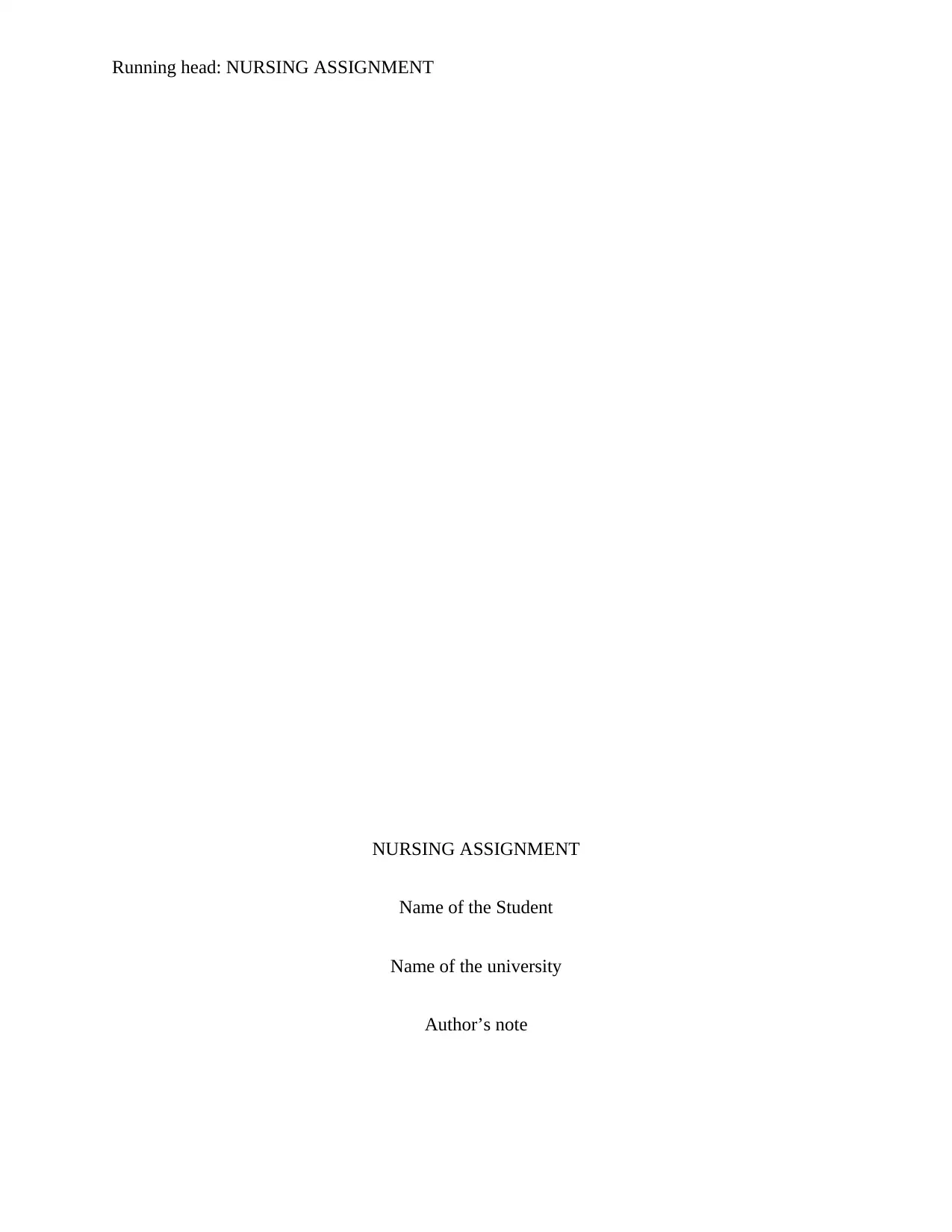
Running head: NURSING ASSIGNMENT
NURSING ASSIGNMENT
Name of the Student
Name of the university
Author’s note
NURSING ASSIGNMENT
Name of the Student
Name of the university
Author’s note
Secure Best Marks with AI Grader
Need help grading? Try our AI Grader for instant feedback on your assignments.
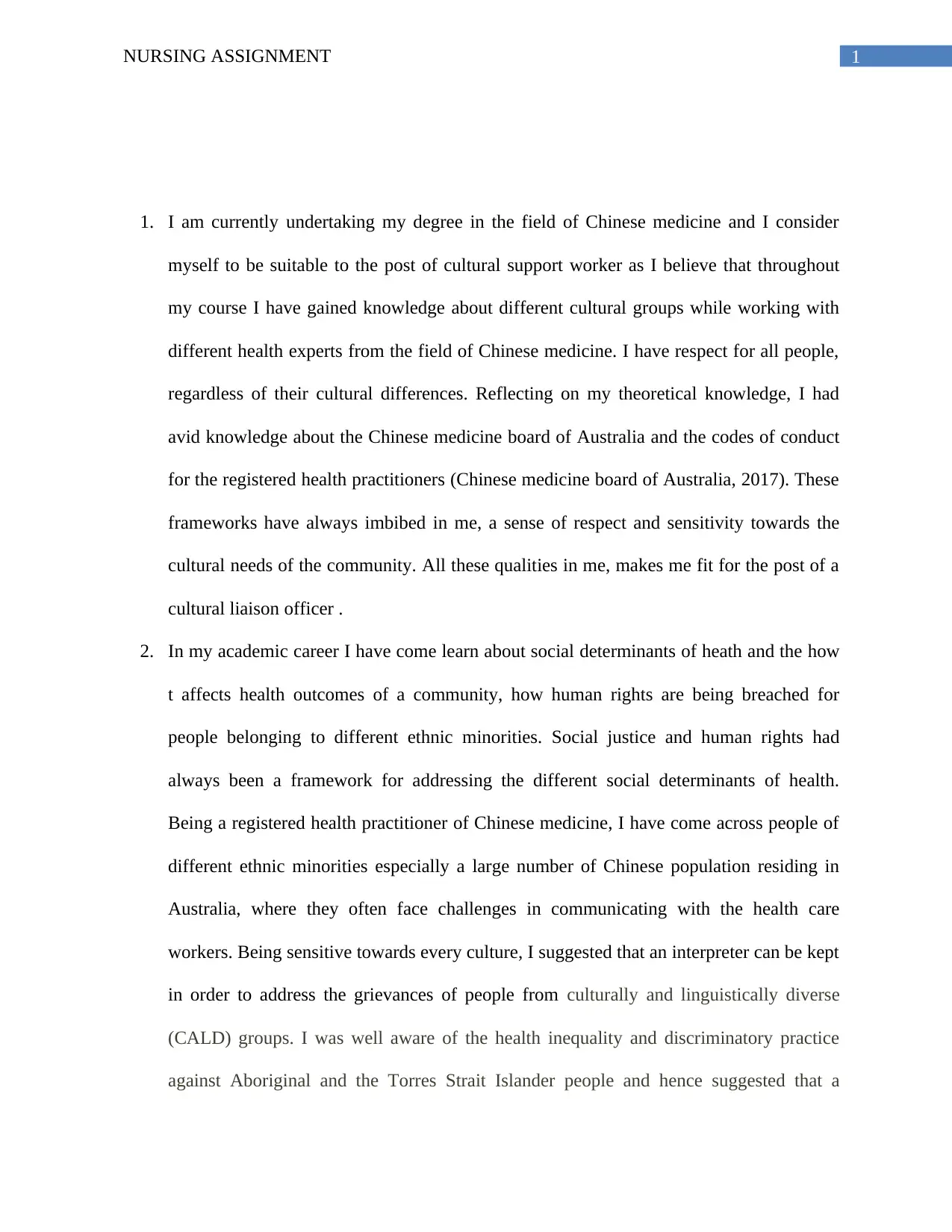
1NURSING ASSIGNMENT
1. I am currently undertaking my degree in the field of Chinese medicine and I consider
myself to be suitable to the post of cultural support worker as I believe that throughout
my course I have gained knowledge about different cultural groups while working with
different health experts from the field of Chinese medicine. I have respect for all people,
regardless of their cultural differences. Reflecting on my theoretical knowledge, I had
avid knowledge about the Chinese medicine board of Australia and the codes of conduct
for the registered health practitioners (Chinese medicine board of Australia, 2017). These
frameworks have always imbibed in me, a sense of respect and sensitivity towards the
cultural needs of the community. All these qualities in me, makes me fit for the post of a
cultural liaison officer .
2. In my academic career I have come learn about social determinants of heath and the how
t affects health outcomes of a community, how human rights are being breached for
people belonging to different ethnic minorities. Social justice and human rights had
always been a framework for addressing the different social determinants of health.
Being a registered health practitioner of Chinese medicine, I have come across people of
different ethnic minorities especially a large number of Chinese population residing in
Australia, where they often face challenges in communicating with the health care
workers. Being sensitive towards every culture, I suggested that an interpreter can be kept
in order to address the grievances of people from culturally and linguistically diverse
(CALD) groups. I was well aware of the health inequality and discriminatory practice
against Aboriginal and the Torres Strait Islander people and hence suggested that a
1. I am currently undertaking my degree in the field of Chinese medicine and I consider
myself to be suitable to the post of cultural support worker as I believe that throughout
my course I have gained knowledge about different cultural groups while working with
different health experts from the field of Chinese medicine. I have respect for all people,
regardless of their cultural differences. Reflecting on my theoretical knowledge, I had
avid knowledge about the Chinese medicine board of Australia and the codes of conduct
for the registered health practitioners (Chinese medicine board of Australia, 2017). These
frameworks have always imbibed in me, a sense of respect and sensitivity towards the
cultural needs of the community. All these qualities in me, makes me fit for the post of a
cultural liaison officer .
2. In my academic career I have come learn about social determinants of heath and the how
t affects health outcomes of a community, how human rights are being breached for
people belonging to different ethnic minorities. Social justice and human rights had
always been a framework for addressing the different social determinants of health.
Being a registered health practitioner of Chinese medicine, I have come across people of
different ethnic minorities especially a large number of Chinese population residing in
Australia, where they often face challenges in communicating with the health care
workers. Being sensitive towards every culture, I suggested that an interpreter can be kept
in order to address the grievances of people from culturally and linguistically diverse
(CALD) groups. I was well aware of the health inequality and discriminatory practice
against Aboriginal and the Torres Strait Islander people and hence suggested that a
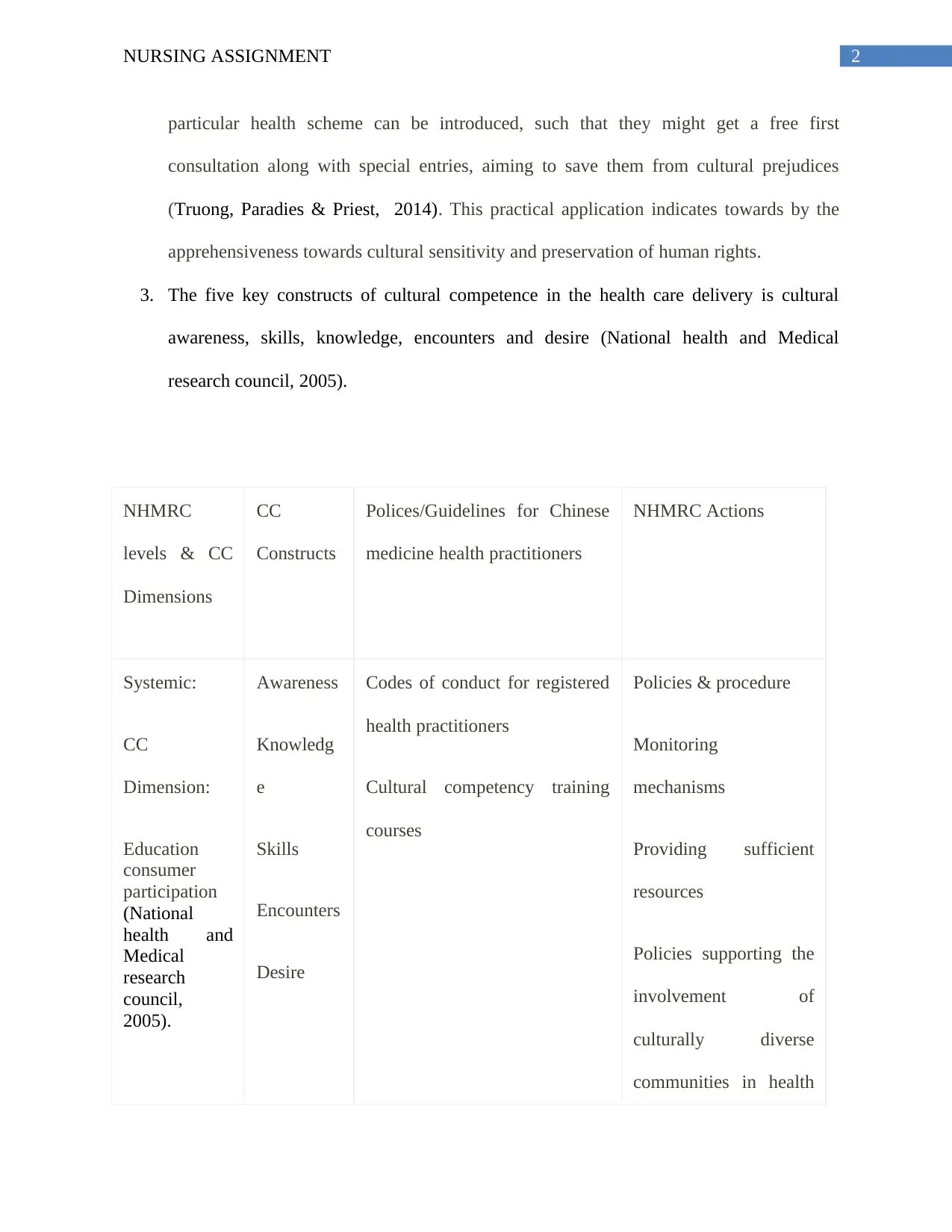
2NURSING ASSIGNMENT
particular health scheme can be introduced, such that they might get a free first
consultation along with special entries, aiming to save them from cultural prejudices
(Truong, Paradies & Priest, 2014). This practical application indicates towards by the
apprehensiveness towards cultural sensitivity and preservation of human rights.
3. The five key constructs of cultural competence in the health care delivery is cultural
awareness, skills, knowledge, encounters and desire (National health and Medical
research council, 2005).
NHMRC
levels & CC
Dimensions
CC
Constructs
Polices/Guidelines for Chinese
medicine health practitioners
NHMRC Actions
Systemic:
CC
Dimension:
Education
consumer
participation
(National
health and
Medical
research
council,
2005).
Awareness
Knowledg
e
Skills
Encounters
Desire
Codes of conduct for registered
health practitioners
Cultural competency training
courses
Policies & procedure
Monitoring
mechanisms
Providing sufficient
resources
Policies supporting the
involvement of
culturally diverse
communities in health
particular health scheme can be introduced, such that they might get a free first
consultation along with special entries, aiming to save them from cultural prejudices
(Truong, Paradies & Priest, 2014). This practical application indicates towards by the
apprehensiveness towards cultural sensitivity and preservation of human rights.
3. The five key constructs of cultural competence in the health care delivery is cultural
awareness, skills, knowledge, encounters and desire (National health and Medical
research council, 2005).
NHMRC
levels & CC
Dimensions
CC
Constructs
Polices/Guidelines for Chinese
medicine health practitioners
NHMRC Actions
Systemic:
CC
Dimension:
Education
consumer
participation
(National
health and
Medical
research
council,
2005).
Awareness
Knowledg
e
Skills
Encounters
Desire
Codes of conduct for registered
health practitioners
Cultural competency training
courses
Policies & procedure
Monitoring
mechanisms
Providing sufficient
resources
Policies supporting the
involvement of
culturally diverse
communities in health

3NURSING ASSIGNMENT
matters
Organisational
specification
Dimension:
education
Codes of conduct
Information and training to the
staffs appropriate to the role in
their organization
Using interpreters
To develop a culturally safe
practice
Being a health care
practitioner of Chinese
medicine, I have to
encounter elderly
Chinese patients or
female aboriginal
patients who might not
be very comfortable in
carry out the
conversation English.
In that case it really
becomes very difficult
to communicate with
these patients and have
to talk to the caregivers
accompanying the
patient. An interpreter
in this case can be
suitable to facilitate
proper communication
between the therapist
matters
Organisational
specification
Dimension:
education
Codes of conduct
Information and training to the
staffs appropriate to the role in
their organization
Using interpreters
To develop a culturally safe
practice
Being a health care
practitioner of Chinese
medicine, I have to
encounter elderly
Chinese patients or
female aboriginal
patients who might not
be very comfortable in
carry out the
conversation English.
In that case it really
becomes very difficult
to communicate with
these patients and have
to talk to the caregivers
accompanying the
patient. An interpreter
in this case can be
suitable to facilitate
proper communication
between the therapist
Secure Best Marks with AI Grader
Need help grading? Try our AI Grader for instant feedback on your assignments.

4NURSING ASSIGNMENT
and the client.
Professional
specification
Awareness
Knowledg
e
Skills
Encounters
Desire
Codes of conduct
Chinese medicine codes of
conduct
Developing cultural sensitivity
by undertaking cultural
competency training course.
Self-learning about cultural
competence
While encountering
aboriginal patients,
we have come
across several cases,
where they had
expressed mistrust
towards Chines
traditional medicine
and more trust
towards their bush
medicines. In such
cases we actually
have made out ways
if really we can rely
on bush medicine
and have assured
them, that they
would get the best
treatment.
and the client.
Professional
specification
Awareness
Knowledg
e
Skills
Encounters
Desire
Codes of conduct
Chinese medicine codes of
conduct
Developing cultural sensitivity
by undertaking cultural
competency training course.
Self-learning about cultural
competence
While encountering
aboriginal patients,
we have come
across several cases,
where they had
expressed mistrust
towards Chines
traditional medicine
and more trust
towards their bush
medicines. In such
cases we actually
have made out ways
if really we can rely
on bush medicine
and have assured
them, that they
would get the best
treatment.
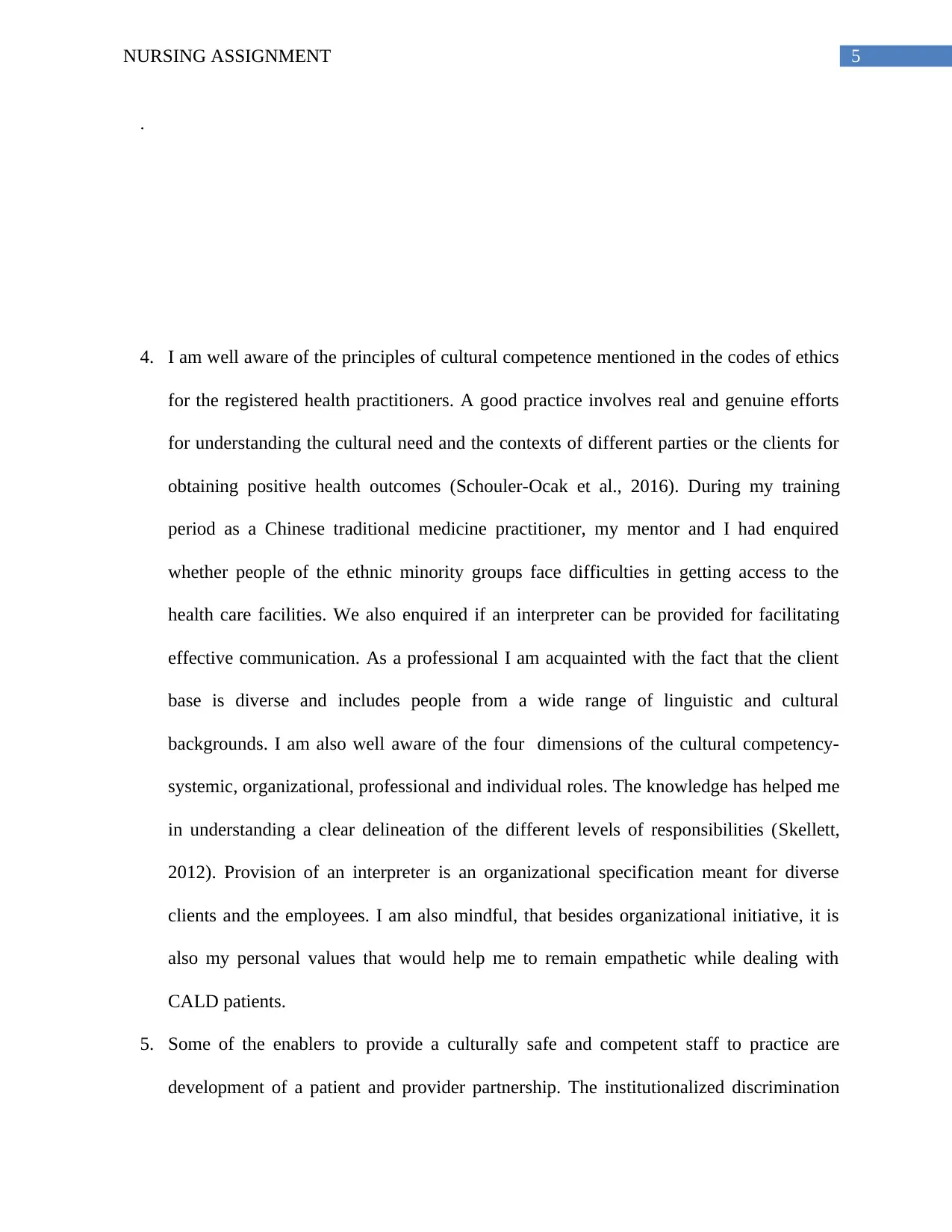
5NURSING ASSIGNMENT
.
4. I am well aware of the principles of cultural competence mentioned in the codes of ethics
for the registered health practitioners. A good practice involves real and genuine efforts
for understanding the cultural need and the contexts of different parties or the clients for
obtaining positive health outcomes (Schouler-Ocak et al., 2016). During my training
period as a Chinese traditional medicine practitioner, my mentor and I had enquired
whether people of the ethnic minority groups face difficulties in getting access to the
health care facilities. We also enquired if an interpreter can be provided for facilitating
effective communication. As a professional I am acquainted with the fact that the client
base is diverse and includes people from a wide range of linguistic and cultural
backgrounds. I am also well aware of the four dimensions of the cultural competency-
systemic, organizational, professional and individual roles. The knowledge has helped me
in understanding a clear delineation of the different levels of responsibilities (Skellett,
2012). Provision of an interpreter is an organizational specification meant for diverse
clients and the employees. I am also mindful, that besides organizational initiative, it is
also my personal values that would help me to remain empathetic while dealing with
CALD patients.
5. Some of the enablers to provide a culturally safe and competent staff to practice are
development of a patient and provider partnership. The institutionalized discrimination
.
4. I am well aware of the principles of cultural competence mentioned in the codes of ethics
for the registered health practitioners. A good practice involves real and genuine efforts
for understanding the cultural need and the contexts of different parties or the clients for
obtaining positive health outcomes (Schouler-Ocak et al., 2016). During my training
period as a Chinese traditional medicine practitioner, my mentor and I had enquired
whether people of the ethnic minority groups face difficulties in getting access to the
health care facilities. We also enquired if an interpreter can be provided for facilitating
effective communication. As a professional I am acquainted with the fact that the client
base is diverse and includes people from a wide range of linguistic and cultural
backgrounds. I am also well aware of the four dimensions of the cultural competency-
systemic, organizational, professional and individual roles. The knowledge has helped me
in understanding a clear delineation of the different levels of responsibilities (Skellett,
2012). Provision of an interpreter is an organizational specification meant for diverse
clients and the employees. I am also mindful, that besides organizational initiative, it is
also my personal values that would help me to remain empathetic while dealing with
CALD patients.
5. Some of the enablers to provide a culturally safe and competent staff to practice are
development of a patient and provider partnership. The institutionalized discrimination
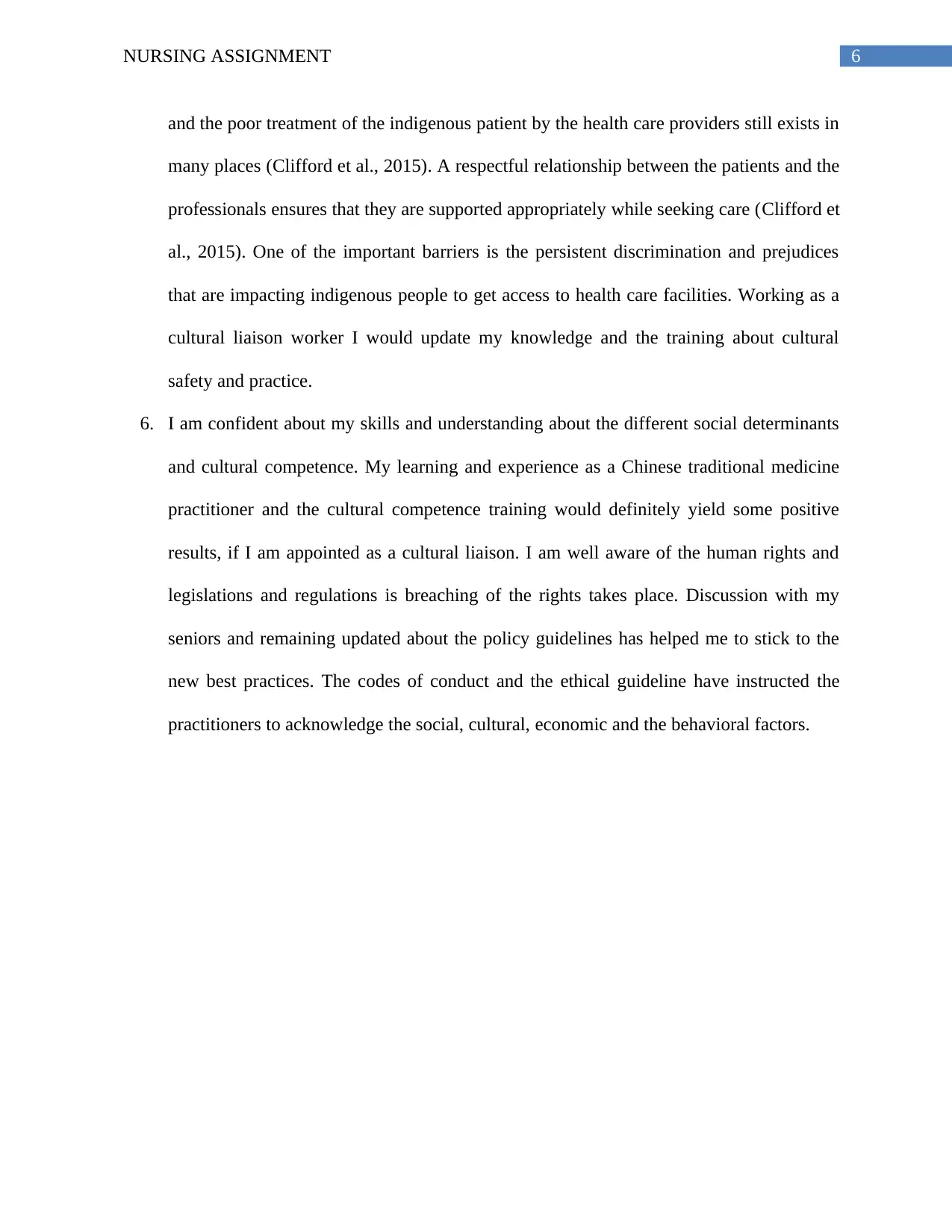
6NURSING ASSIGNMENT
and the poor treatment of the indigenous patient by the health care providers still exists in
many places (Clifford et al., 2015). A respectful relationship between the patients and the
professionals ensures that they are supported appropriately while seeking care (Clifford et
al., 2015). One of the important barriers is the persistent discrimination and prejudices
that are impacting indigenous people to get access to health care facilities. Working as a
cultural liaison worker I would update my knowledge and the training about cultural
safety and practice.
6. I am confident about my skills and understanding about the different social determinants
and cultural competence. My learning and experience as a Chinese traditional medicine
practitioner and the cultural competence training would definitely yield some positive
results, if I am appointed as a cultural liaison. I am well aware of the human rights and
legislations and regulations is breaching of the rights takes place. Discussion with my
seniors and remaining updated about the policy guidelines has helped me to stick to the
new best practices. The codes of conduct and the ethical guideline have instructed the
practitioners to acknowledge the social, cultural, economic and the behavioral factors.
and the poor treatment of the indigenous patient by the health care providers still exists in
many places (Clifford et al., 2015). A respectful relationship between the patients and the
professionals ensures that they are supported appropriately while seeking care (Clifford et
al., 2015). One of the important barriers is the persistent discrimination and prejudices
that are impacting indigenous people to get access to health care facilities. Working as a
cultural liaison worker I would update my knowledge and the training about cultural
safety and practice.
6. I am confident about my skills and understanding about the different social determinants
and cultural competence. My learning and experience as a Chinese traditional medicine
practitioner and the cultural competence training would definitely yield some positive
results, if I am appointed as a cultural liaison. I am well aware of the human rights and
legislations and regulations is breaching of the rights takes place. Discussion with my
seniors and remaining updated about the policy guidelines has helped me to stick to the
new best practices. The codes of conduct and the ethical guideline have instructed the
practitioners to acknowledge the social, cultural, economic and the behavioral factors.
Paraphrase This Document
Need a fresh take? Get an instant paraphrase of this document with our AI Paraphraser
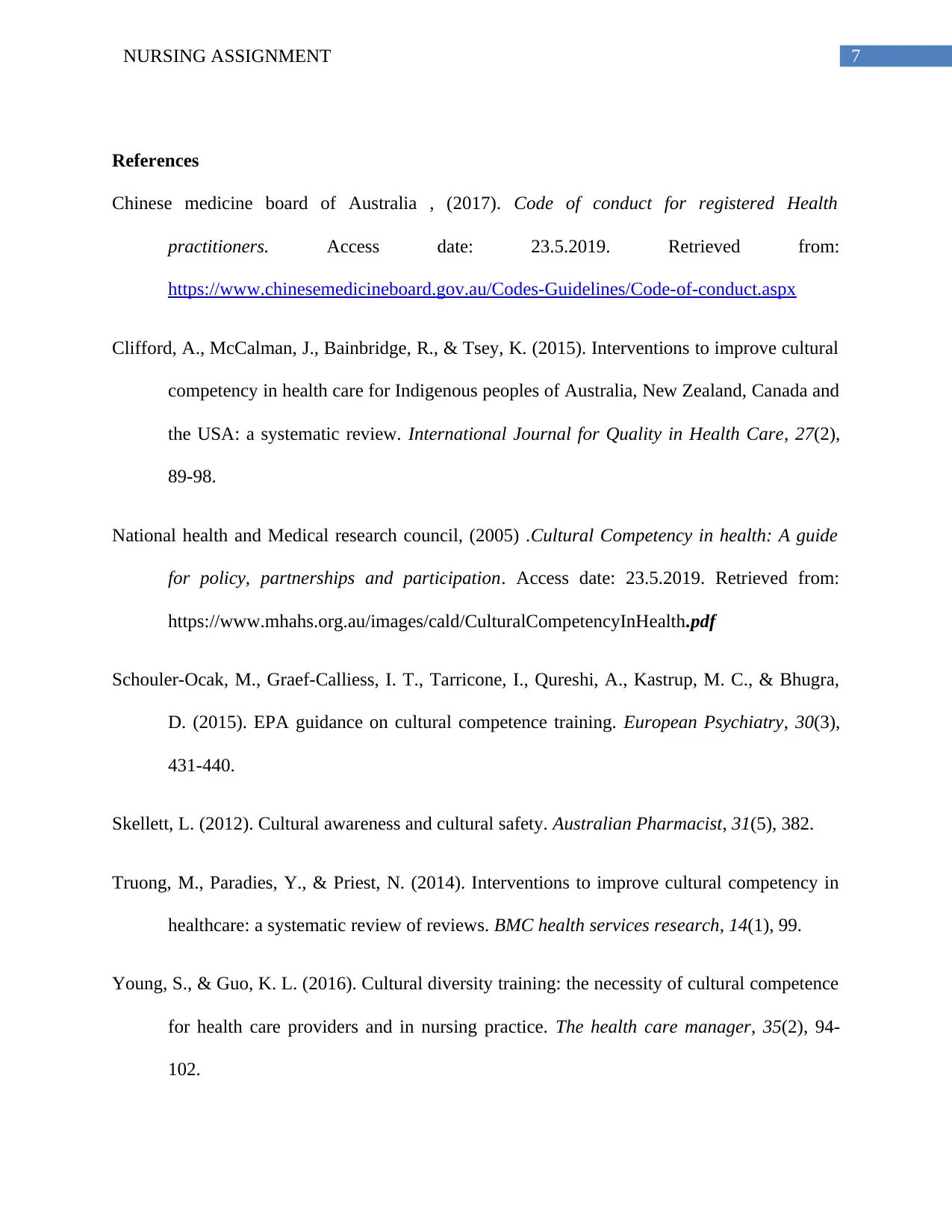
7NURSING ASSIGNMENT
References
Chinese medicine board of Australia , (2017). Code of conduct for registered Health
practitioners. Access date: 23.5.2019. Retrieved from:
https://www.chinesemedicineboard.gov.au/Codes-Guidelines/Code-of-conduct.aspx
Clifford, A., McCalman, J., Bainbridge, R., & Tsey, K. (2015). Interventions to improve cultural
competency in health care for Indigenous peoples of Australia, New Zealand, Canada and
the USA: a systematic review. International Journal for Quality in Health Care, 27(2),
89-98.
National health and Medical research council, (2005) .Cultural Competency in health: A guide
for policy, partnerships and participation. Access date: 23.5.2019. Retrieved from:
https://www.mhahs.org.au/images/cald/CulturalCompetencyInHealth.pdf
Schouler-Ocak, M., Graef-Calliess, I. T., Tarricone, I., Qureshi, A., Kastrup, M. C., & Bhugra,
D. (2015). EPA guidance on cultural competence training. European Psychiatry, 30(3),
431-440.
Skellett, L. (2012). Cultural awareness and cultural safety. Australian Pharmacist, 31(5), 382.
Truong, M., Paradies, Y., & Priest, N. (2014). Interventions to improve cultural competency in
healthcare: a systematic review of reviews. BMC health services research, 14(1), 99.
Young, S., & Guo, K. L. (2016). Cultural diversity training: the necessity of cultural competence
for health care providers and in nursing practice. The health care manager, 35(2), 94-
102.
References
Chinese medicine board of Australia , (2017). Code of conduct for registered Health
practitioners. Access date: 23.5.2019. Retrieved from:
https://www.chinesemedicineboard.gov.au/Codes-Guidelines/Code-of-conduct.aspx
Clifford, A., McCalman, J., Bainbridge, R., & Tsey, K. (2015). Interventions to improve cultural
competency in health care for Indigenous peoples of Australia, New Zealand, Canada and
the USA: a systematic review. International Journal for Quality in Health Care, 27(2),
89-98.
National health and Medical research council, (2005) .Cultural Competency in health: A guide
for policy, partnerships and participation. Access date: 23.5.2019. Retrieved from:
https://www.mhahs.org.au/images/cald/CulturalCompetencyInHealth.pdf
Schouler-Ocak, M., Graef-Calliess, I. T., Tarricone, I., Qureshi, A., Kastrup, M. C., & Bhugra,
D. (2015). EPA guidance on cultural competence training. European Psychiatry, 30(3),
431-440.
Skellett, L. (2012). Cultural awareness and cultural safety. Australian Pharmacist, 31(5), 382.
Truong, M., Paradies, Y., & Priest, N. (2014). Interventions to improve cultural competency in
healthcare: a systematic review of reviews. BMC health services research, 14(1), 99.
Young, S., & Guo, K. L. (2016). Cultural diversity training: the necessity of cultural competence
for health care providers and in nursing practice. The health care manager, 35(2), 94-
102.
1 out of 8
Related Documents
Your All-in-One AI-Powered Toolkit for Academic Success.
+13062052269
info@desklib.com
Available 24*7 on WhatsApp / Email
![[object Object]](/_next/static/media/star-bottom.7253800d.svg)
Unlock your academic potential
© 2024 | Zucol Services PVT LTD | All rights reserved.





